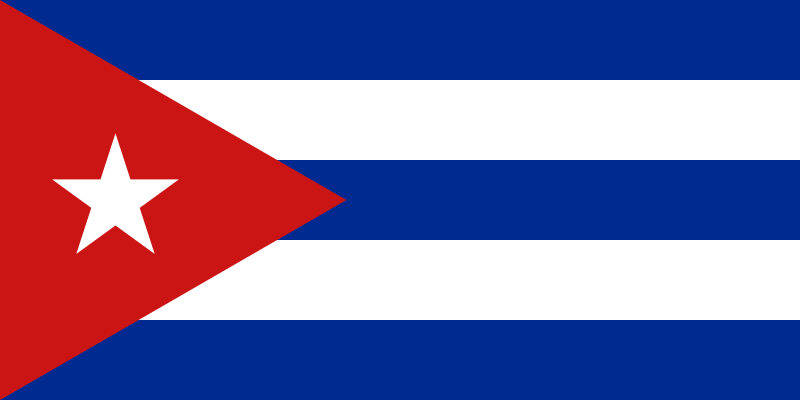Historical Context:
The flag's roots are intricately intertwined with Cuba's arduous endeavor to break free from the yoke of Spanish colonial domination. The flag's blueprint was birthed from the vision of Narciso López, a fervent Venezuelan-born revolutionary and filibuster, who set his sights on liberating Cuba from Spanish subjugation during the mid-19th century.
In the year 1850, López unveiled the inaugural Cuban flag during his bold ventures to the island. This early iteration of the flag boasted three cobalt blue stripes and two alabaster white ones, with an ivory star gracing a sapphire canton. As time progressed, this design underwent alterations, eventually crystallizing into the emblematic arrangement that characterizes the flag today.
Symbolism and Design:
The five alternating horizontal stripes woven into the fabric of the flag are replete with profound symbolism:
Blue Stripes (3): These vertical bands epitomize Cuba's three historical partitions: the Western, Central, and Eastern regions. Beyond this, they embody the nation's interconnectedness with the encircling oceans—a dual representation, encompassing both a geographical trait and an emblem of exploration and unfettered liberty.
White Stripes (2): The twin bands of immaculate white are emblematic of the unadulterated ideals driving the Cuban populace's aspirations. They mirror the guiding principles propelling their unwavering endeavor for independence and self-sovereignty. White, oftentimes a symbol of tranquility, illumination, and optimism, imparts its virtues to this design.
Red Triangle: Prominently emblazoned on the hoist side of the flag, the crimson equilateral triangle embodies the most potent allegorical significance. This geometric figure serves as a poignant testament to the bloodshed and unflinching sacrifices borne by the Cuban people throughout their relentless struggle for emancipation. The triangle traces its lineage to the Masonic ideals of freedom, equality, and brotherhood—tenets that held substantial sway during the nascent phases of Cuba's push for independence.
Size and Proportions:
The flag adheres to the customary dimensions of 1:2, signifying a width twice the span of its height. The scarlet triangle claims one-quarter of the flag's width, extending seamlessly from the hoist side to converge at the heart of the design.
Modern Significance:
Though the flag's contemporary manifestation was officially ratified on May 20, 1902, coinciding with Cuba's nominal emancipation from the United States, its profound political and ideological significance gained pronounced prominence subsequent to the resounding success of the Cuban Revolution, steered by the resolute leadership of Fidel Castro and Che Guevara during the late 1950s.
Since the revolutionary triumph of 1959, the flag has evolved into a central emblem of Cuba's socialist administration. It unfurls as a standard-bearer of self-determination, social equity, and anti-imperialism—cornerstones that anchored the very core of the revolutionary movement. The flag endures as an emblem of national pride, fortitude, and defiance against external influences.
In the international arena, Cuba's flag assumes the mantle of an ambassador, eloquently representing the nation's distinctive history and unflinching commitment to preserving its autonomy and distinct identity, notwithstanding historical tribulations and the ever-evolving tapestry of political dynamics.
In summation, the flag of Cuba transcends being a mere visual emblem of a geographical entity; it encapsulates the indomitable spirit of struggle, the willingness for sacrifice, and the unyielding determination that have perennially characterized Cuba's unswerving odyssey for autonomy and self-governance. The interplay of its colors, stripes, and triangle conveys a resounding narrative—a testament to a unified populace ardently pursuing liberty and a more luminous future.
Last Updated on: August 08, 2023